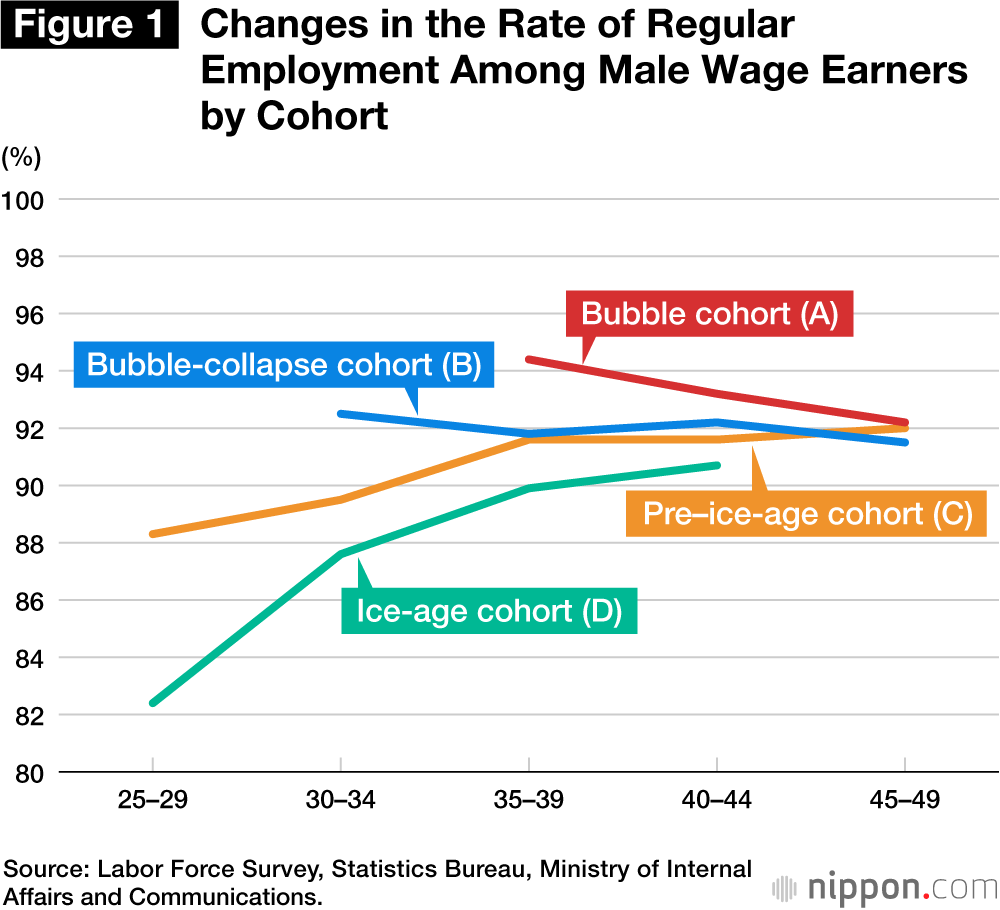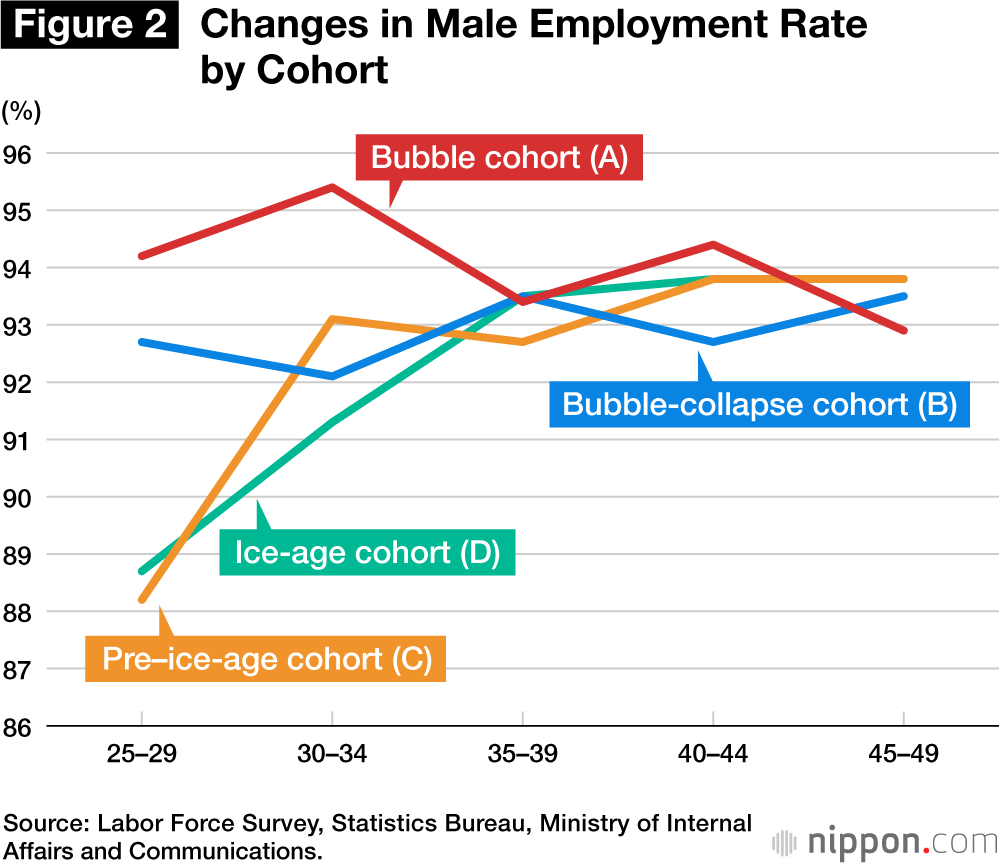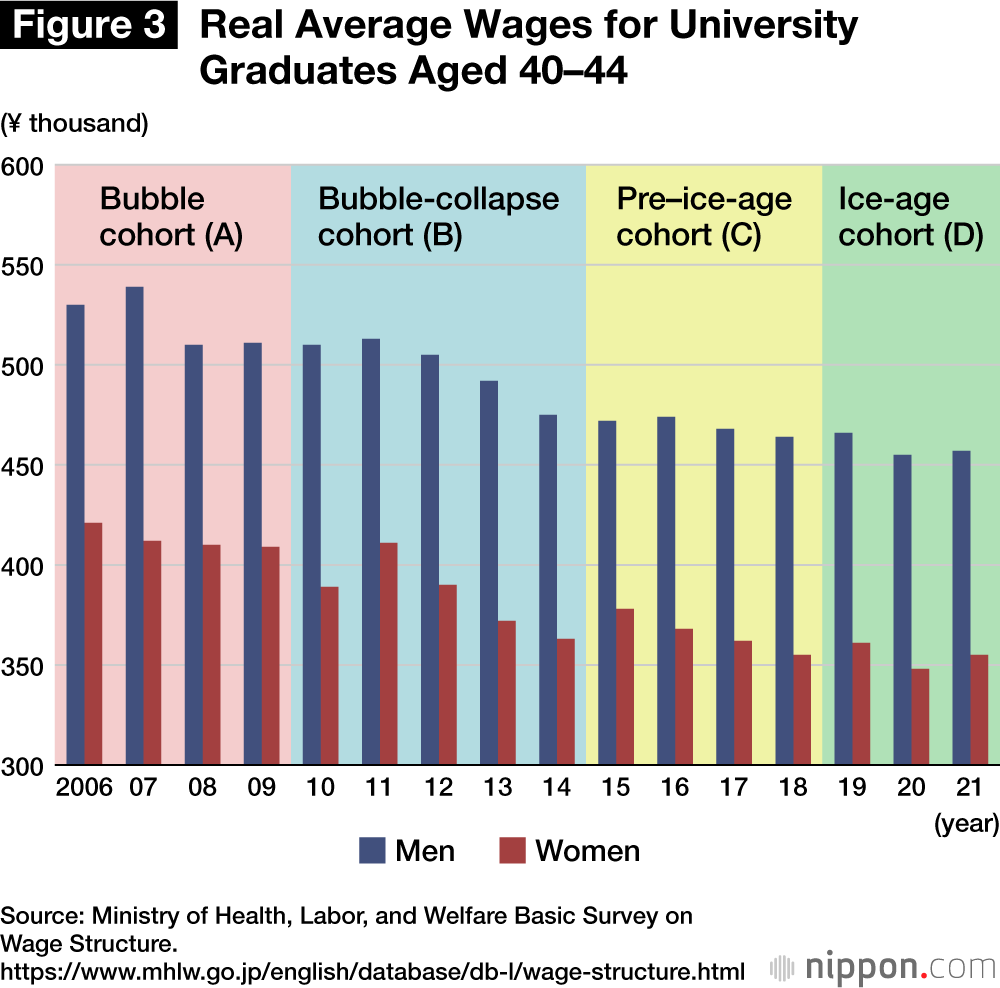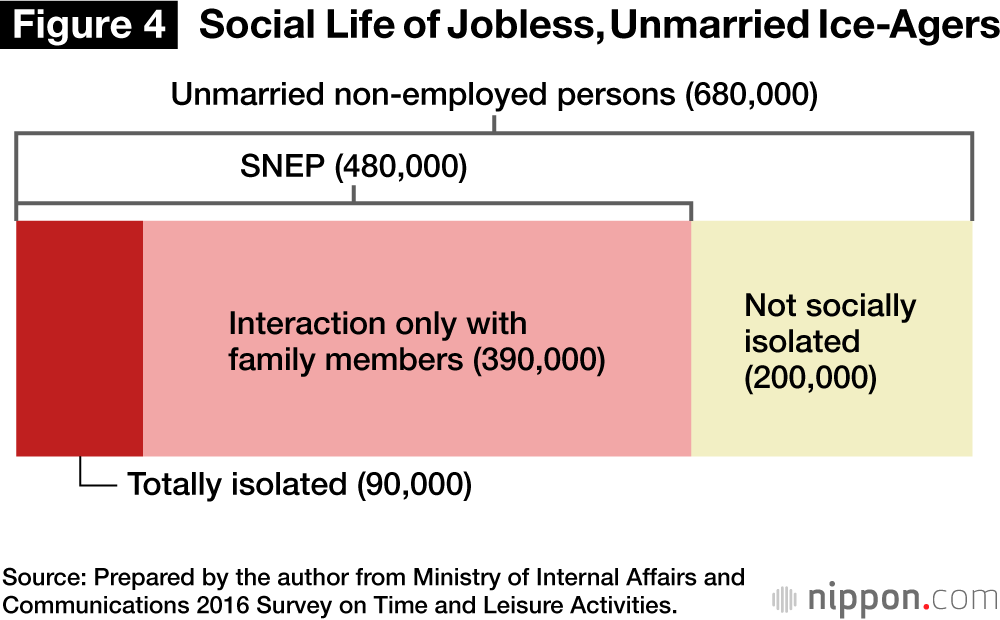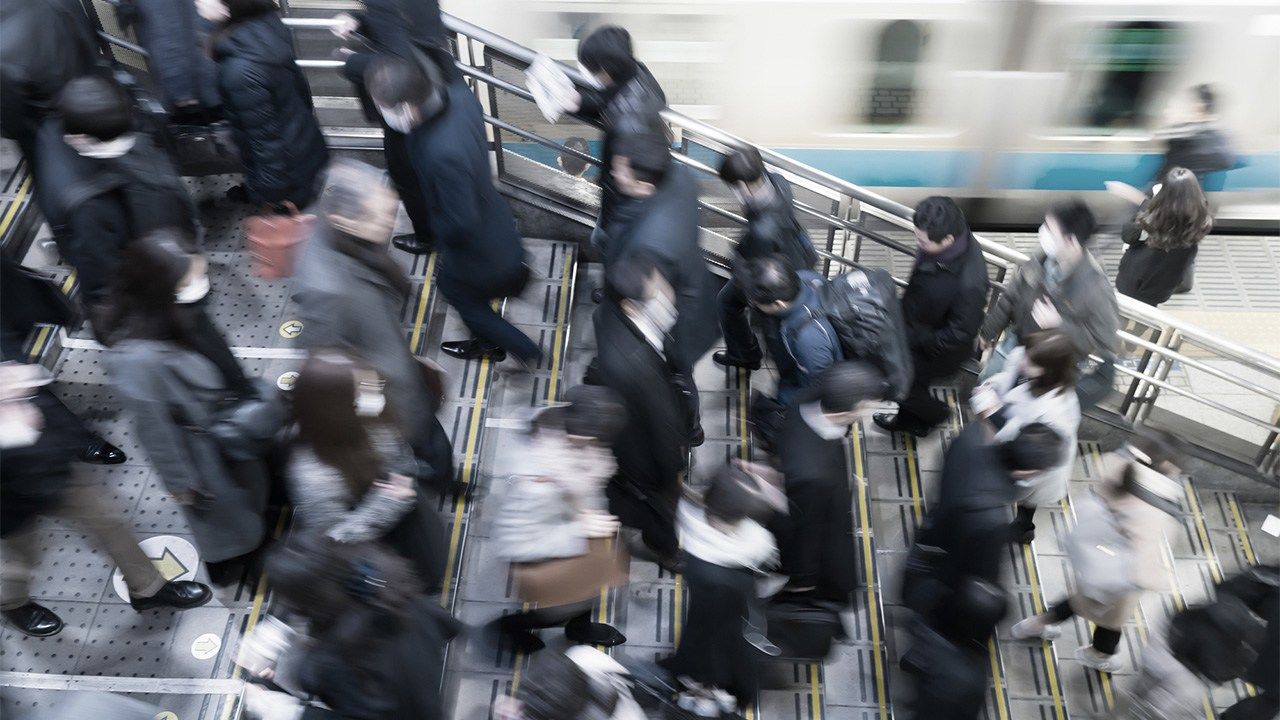
Revisiting Japan’s Lost Generation
Tracking the Legacy of the Employment Ice Age: A Data-Based Assessment
Economy Politics- English
- 日本語
- 简体字
- 繁體字
- Français
- Español
- العربية
- Русский
From the late 1990s to the early years of the twenty-first century, the Japanese economy was mired in a deep recession. Many companies froze or sharply curtailed their annual recruitment of permanent employees, with the result that young people who left school during that time found it difficult to secure regular employment upon graduating. This period has been dubbed the “employment ice age.”
In Japan, regular employees—who enjoy substantial advantages in terms of job security, pay, and benefits—are typically hired en masse, immediately after graduation. For this reason, many of those who graduated during the employment ice age, having missed the window for securing regular employment, were obliged to accept low-paying nonregular positions or settle for a series of temporary jobs. But how long did their hardship continue?
Initial Findings
Some years ago, my colleagues and I published research comparing the enduring impact of a recession on the job situation of young males in Japan and the United States. We concluded that the influence of high unemployment at graduation on poor job conditions later on was stronger in Japan. Japanese high schools offer intensive guidance and placement services for young people wishing to find work upon graduation instead of continuing their education. Our study found that for those who failed to secure a satisfactory position immediately after graduation, ongoing employment challenges were greater in Japan than in the United States.
Our study also discerned signs that, even in Japan, the long-term impact of the recession on graduates’ wages and job stability was waning over time; with age, it appeared, those who graduated during the recession were gradually moving into more stable, higher-paying jobs. But since the data for our analysis extended only into the early 2000s, the study shed no light on subsequent trends. (At the same time, the employment ice age witnessed a sharp drop in the percentage of Japanese high school students opting to enter the work force directly after graduation.)
Today, most of those who left school during the employment ice age are in their 40s. In the following, we will see how the long-term employment situation of these “ice-agers” compares with that of earlier cohorts and consider the implications.
Transitioning to Regular Employment
For the current analysis, I grouped the population under study into seven cohorts, each consisting of those aged 20–24 (the general vicinity of graduation age) in a particular year, and labeled them according to Japan’s economic situation at the time. The first group, which I call the “bubble cohort,” consists of people aged 20–24 in 1987, when the so-called bubble economy was at its height. The second group is labeled the “bubble-collapse cohort” because its members were between 20 and 24 in 1992, just after the so-called bubble economy collapsed. Next comes the “pre–ice-age cohort,” which was 20–24 years old in 1997, as unemployment began shooting up. The “ice-age cohort” was 20–24 in 2002, when unemployment hit a historic high. The 2007 group, which came of age when the employment situation had temporarily improved, is named the “post–ice-age cohort.” The 2012 group is dubbed the “Lehman/earthquake” cohort, since it experienced the impact of both the 2008–9 financial crisis (called the Lehman shock in Japan) and the Great East Japan Earthquake of 2011. And finally, we have the “labor-shortage cohort,” which came of age around 2017, as Japan was grappling with a shrinking labor force.
Table 1. Graduation/Employment Cohorts by Year and Economic Phase
| Year | Name of age 20–24 cohort |
|---|---|
| 1987 | A. Bubble cohort |
| 1992 | B. Bubble-collapse cohort |
| 1997 | C. Pre–ice-age cohort |
| 2002 | D. Ice-age cohort |
| 2007 | E. Post–ice-age cohort |
| 2012 | F. Lehman/earthquake cohort |
| 2017 | G. Labor-shortage cohort |
In 2002, the government’s Labor Force Survey began gathering data on regular and nonregular employees using its current methodology. From these data we can ascertain the percentage of male wage earners in each cohort who were engaged in regular employment over the years. Figure 1 plots that data for cohorts A through D from 2002 to 2022, in five-year increments.
Comparing working males in the 25–29 age bracket by cohort, we find that the rate of regular employment was six points lower in the ice-age cohort (D) than in the pre–ice-age cohort (C). By age 30–34, the regular-employment rate among cohort D had risen, but it was still about 5 percentage points lower than in the bubble-collapse cohort (B) at the same age. From this we can see that the employment challenges of the ice-agers persisted through their early thirties.
However, the difference between the ice-age cohort and cohorts B and C diminishes by age 34–39, although cohort A still enjoys a substantially higher rate of regular employment. Between this age bracket and the next (40–44), the rate of regular employment rises fastest among the ice-age cohort, substantially reducing the gap. By age 45–49, the disparity between the bubble and pre–ice-age cohorts has almost disappeared. This trend suggests that in another five years, the ice-age cohort will have caught up with the previous cohort with respect to regular employment among male wage earners.
But what about those who failed to find employment after graduation? Much has been written about ice-agers who gave up the search for a suitable job and remained economically dependent on their parents into middle age. The related problem of middle-aged shut-ins, or hikikomori, is frequently linked to the employment ice age as well.
Figure 2 tracks the employment rate of cohorts A, B, C, and D at different ages. In the 25–29 bracket, joblessness is substantially more in the ice-age cohort than in cohorts A and B, and the disparity persists among those in their early 30s. However, by the time the different cohorts reach their mid-thirties, the gap has closed.
In other words, the government’s data do not substantiate the assumption that men who graduated during the employment ice age are more apt to find themselves unemployed in middle age.
Mitigating Factors
To recap, the data we have reviewed here suggest that while men in the ice-age cohort faced significant challenges finding work after graduation, they had essentially achieved employment parity with the previous cohort by the time they were in their forties. How do we account for this encouraging turn of events?
One contributing factor may be a government program instituted in 2020 to assist ice-agers in securing employment. According to the Ministry of Health, Labor, and Welfare, more than 290,000 members of this group have found regular employment through the government’s Hello Work service since the program was launched.
Another important factor may have been employment programs targeting youth and younger adults, which Japan began implementing in earnest around 2000 in the midst of the employment ice age. Before that, Japan had invested little in youth employment programs compared with other developed countries, but today governments offer various forms of support to younger job seekers all over Japan, extending to those in their thirties.
As noted above, moreover, our earlier research suggests that while the impact of the post-bubble recession on Japanese graduates persisted for a while in the form of job instability and low pay, the gap was already beginning to close somewhat by the early years of the twenty-first century. It seems likely that that trend continued.
The employment program targeting ice-agers, originally set to expire after three years, has been extended for another two. But the statistics we have seen suggest that, viewed from a macro perspective, this cohort is already close to achieving equality with others in respect to employment rate and the percentage of wage earners classified as regular employees.
A similar trend can be seen among women working outside the home. Women who graduated during the employment ice age were less likely than other cohorts to secure regular employment upon graduation, but by the time they were in their forties, they were doing better than the previous cohort in this respect. Moreover, the overall employment rate of women in the ice-age cohort has exceeded that of the previous cohort in every age bracket. These trends have continued through the labor-shortage cohort (G). There is little doubt that, in Japan as elsewhere, the overall employment status of women has improved over the years.
All of that said, it would be a mistake to conclude that the economic woes of the ice-age generation are behind them.
Persistent Wage Inequality
Figure 3 charts the year-by-year change in real average monthly wages paid to male and female university graduates in the 40–44 age bracket, allowing us to compare wages by cohort and by gender.
As the chart indicates, the average real monthly wages for 40–44-year-old males held fairly steady, around ¥500,000 , even when the bubble-collapse cohort reached that age. However, by the time the pre–ice-age cohort was 40–44 years old, wages had dropped to about ¥470,000. For the ice-age cohort, they fell even further, to slightly more than ¥450,000. In short, while the ice-age cohort has managed to close the gap with earlier cohorts in terms of employment status, it has never caught up with respect to wages. Among women, pay has remained low even as opportunities for regular employment have increased.
Early in this century, amid continued economic stagnation, Japanese companies came under pressure to shift away from a pay scale tied primarily to age to a more meritocratic system. But it was difficult to persuade established employees, hired under the old system, to accept a wholesale change. Many companies made the transition during the employment ice age, with the result that those hired during this period began work under a new system, in which guaranteed age-related wage increases were substantially smaller. This shift may be one reason for the persistence of lower wages among ice-agers. In addition, in the years since the ice-age, young employees have had fewer opportunities for intensive, systematic on-the-job training and skills development, a situation which may also have contributed to wage stagnation.
The Lost Generation in an Aging Society
As we have seen, the overall employment rate has not been substantially lower among middle-aged ice-agers than among earlier cohorts. But it could be that the socioeconomic difficulties facing people who remain jobless are worsening.
In an earlier article, I discussed the phenomenon of solitary non-employed persons (SNEPs), defined as persons aged 20 to 59 who are single, jobless, and spend the bulk of their time either alone or in the company of immediate family members. The ranks of SNEPs have risen rapidly in Japan since around 2010. Analyzing data from the government’s Survey on Time Use and Leisure Activities, I found that a large proportion of unmarried, jobless ice-agers were isolated individuals with little social interaction outside their immediate families (figure 4). This group includes the totally withdrawn, housebound recluses known as hikikomori.
In recent years, the media has begun to highlight the worsening economic and social plight of hikikomori and other SNEPs as they advance through middle age while their retired parents, on whom they depend, are nearing the end of their lives. Mounting public concern over the “80-50 problem” (referring to the age group of the parents and their children, respectively) may well have been a political factor behind the government’s decision to launch an employment program targeting the ice-age generation. Henceforth, however, the focus of government aid to the ice-agers is likely to shift from individual employment assistance to welfare programs for impoverished households.
Many gainfully employed ice-agers also face an uncertain future. Working for relatively low pay, they have often had difficulty saving up for old age, particularly in this era of rock-bottom interest rates. As a result, retirement could be a long way off. Partially overlapping with Japan’s second baby-boom generation, the ice-age generation will be a key focus of Japanese policy makers as they grapple with the challenges of a dwindling labor supply and an aging society.
(Originally published in Japanese. Banner photo: © Pixta.)
